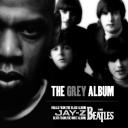The Grey Zone
March 16th, 2008 by nlang1Fan Artifact Presentation by Noah Lang and Kathy Alexeeff

In 2004 Brian Burton, also known as DJ Danger Mouse, produced a mashup album combining The Beatles self-titled 1968 album (also known as The White Album) and Jay-Z’s 2003 album The Black Album. Originally intended only for close friends and to encourage further mashup experiments, the album’s popularity spread rapidly culminating in EMI sending Burton cease and desist letters regarding the album’s continued release and promotion.
Later in 2004, music video directing team Ramon and Pedro released a music video mashing up concert performance footage of Jay-Z and footage of The Beatles playing on The Ed Sullivan Show. The video attracted similar internet popularity and picked up much of the same mainstream coverage that Burton’s mashup was given.
You can watch the video here.
The Grey Album demonstrates several key concepts introduced by Chris Anderson in The Long Tail. As a niche market product, The Grey Album was never intended for a large audience but through the internet the album reached the same audience an industry backed “hit” would hope to reach. Despite its widespread appeal and acclaim, The Grey Album has never been commercially released and Burton has received no direct compensation for his work. Since the album’s “release” Burton has essentially been co-opted by the mainstream he originally was outside of and ironically he is currently contracted by the same record label which threatened to sue him, EMI. Entertainment Weekly named The Grey Album record of the year in 2004 and GQ named Burton one of their “men of the year” following the album’s popularity and mainstream coverage. Oh yeah, he also won a grammy for his production work on the Gorillaz second studio album, Demon Days.
Basically Burton was able to leverage a non-commercially viable product into a successful music career on products that are commercially viable such as the Gorillaz album and further works with MF Doom, Gnarls Barkley and an upcoming collaboration with Beck. Anderson describes this trend: “ such profitless publishing can be lucrative all the same…such [works] are best seen as enhancing the reputation of their authors”.
However, such liberal use of copyrighted material is not without the threat of potential litigation. Following EMI’s extensive litigation to prevent further “releases” of Danger Mouse’s work, an NPO known as Downhill Battle organized an event called Grey Tuesday which took place on February 24, 2004. The event called for websites to post copies of the album for free download in order to protest the record industry’s apparent ignorance of fair use laws that permit limited use of copyrighted materials. The event culminated in over 100,000 downloads from participating websites and not a single charge filed in court against the organizers.
The Grey Album and further related media as well as Downhill Battle’s Grey Tuesday, touch upon issues we have previously discussed in class with the Grey Tuesday representing an apparent fan community protecting transformative works against the powers that be. New concepts addressed in the readings include the continuing issue of copyright and its relation to new media as well as the utility of seemingly non-commercially viable products.
Things to consider-
(1) Should we care about copyright when the copyright owner is not the artist? (I.E.-Michael Jackson originally controlled the Beatles catalogue after outbidding Paul McCartney for the rights)
(2) Is it possible for other forms of entertainment to be as thoroughly digitalized as music has been transformed? For example, will books remain physical objects or will they too become digitalized?
Posted in Uncategorized | 1 Comment »